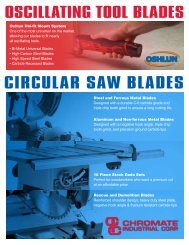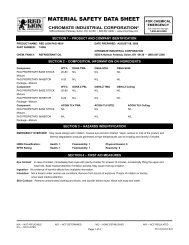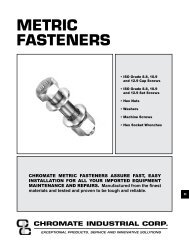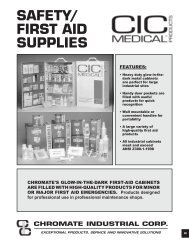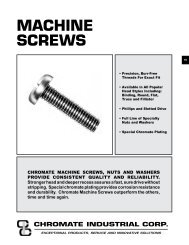74011 - Chromate Industrial Corporation
74011 - Chromate Industrial Corporation
74011 - Chromate Industrial Corporation
You also want an ePaper? Increase the reach of your titles
YUMPU automatically turns print PDFs into web optimized ePapers that Google loves.
TM<br />
MATERIAL SAFETY DATA SHEET<br />
CHROMATE INDUSTRIAL CORPORATION ®<br />
5250-A Naiman Parkway, Solon, OH 44139 • 888-567-2206 • www.chromate.com<br />
SECTION 1 – PRODUCT AND COMPANY IDENTIFICATION<br />
FOR CHEMICAL<br />
EMERGENCY<br />
Call ChemTrec day/night:<br />
1-800-424-9300<br />
PRODUCT NAME: RED LION SATIN BLACK PAINT<br />
PART NUMBER: <strong>74011</strong><br />
PRODUCT TYPE: Paint<br />
DATE PREPARED: SEPTEMBER 12, 2008<br />
CHROMATE INDUSTRIAL CORPORATION<br />
5250-A Naiman Parkway, Solon, OH 44139 • (888) 567-2206<br />
SECTION 2 – COMPOSITION / DATA ON COMPONENTS<br />
Chemical characterization<br />
Description: Mixture of the substances listed below with nonhazardous additions.<br />
Dangerous components:<br />
67-64-1 Acetone 25-50%<br />
Danger: 2.6/2<br />
Warning: 3.3/2A, 3.8/3<br />
68476-86-8 Petroleum Gases, liquefied, sweetened 10-25%<br />
Danger: 2.2/1<br />
Warning: 2.5/C<br />
108-88-3 Toluene 10-25%<br />
Danger: 2.6/2; 3.10/1, 3.7/2<br />
Warning: 3.2/2, 3.3/2A, 3.8/3<br />
110-19-0 Isobutyl Acetate 2.5-10%<br />
Danger: 2.6/2<br />
ACRYLIC resin 2.5-10%<br />
Warning: 3.2/2, 3.3/2A, 3.8/3<br />
1330-20-7 Xylene 2.5-10%<br />
Danger: 3.1.D/3, 3.1.I/4, 3.2/2<br />
Warning: 2.6/3<br />
78-93-3 Butanone 1-2.5%<br />
Danger: 2.6/2<br />
Warning: 3.3/2A, 3.8/3<br />
123-86-4 n-Butyl Acetate 1-2.5%<br />
Warning: 2.6/3; 3.8/3<br />
N/A — NOT APPLICABLE N/D — NOT DETERMINED N/E — NONE ESTABLISHED N/R — NOT REGULATED<br />
N/L — NOT LISTED<br />
Page 1 of 8<br />
REV 09/12/2008 BJM
RED LION RESEARCH — CHROMATE INDUSTRIAL CORPORATION RED LION SATIN BLACK PAINT P/N <strong>74011</strong><br />
SECTION 3 – HAZARDS INDENTIFICATION<br />
Hazard description: Harmful<br />
Extremely Flammable<br />
Information pertaining to particular dangers for man and environment:<br />
The product has to be labeled due to the calculation procedure of international guidelines.<br />
Warning! Pressurized container.<br />
Extremely flammable.<br />
Harmful by inhalation.<br />
Irritating to eyes, respiratory system and skin.<br />
Danger of serious damage to health by prolonged exposure.<br />
Possible risk of harm to the unborn child.<br />
Pressurized container: Protect from sunlight and do not expose to temperatures exceeding 50°C, i.e. electric lights. Do not pierce or<br />
burn, even after use.<br />
92.0 % by mass of the contents are flammable<br />
Keep out of the reach of children.<br />
Classification system:<br />
The classification was made according to the latest editions of international substances lists, and expanded upon from company and<br />
literature data.<br />
NFPA ratings (scale 0 - 4): Health: 2 Fire: 4 reactivity: 0<br />
HMIS-ratings (scale 0 - 4): Health: 2 Fire: 4 reactivity: 0<br />
GHS label elements:<br />
Danger:<br />
2.2/1 - Extremely flammable gas.<br />
2.3/1 - Extremely flammable aerosol.<br />
Warning:<br />
3.7/2 - Suspected of damaging fertility or the unborn child.<br />
Warning:<br />
3.1/4 - Harmful if inhaled.<br />
3.2/2 - Causes skin irritation.<br />
3.3/2A - Causes serious eye irritation.<br />
3.8/3 - May cause respiratory irritation.<br />
Prevention: Obtain special instructions before use. Do not handle until all safety precautions have been read and understood.Keep away from<br />
heat/sparks/open flames/hot surfaces. - No smoking. Do not spray on an open flame or other ignition source.<br />
Pressurized container: Do not pierce or burn, even after use. Avoid breathing dust/fume/gas/mist/vapors/spray. Wash thoroughly after<br />
handling. Use only outdoors or in a well-ventilated area.Wear protective gloves/protective clothing/eye protection/<br />
face protection. Use personal protective equipment as required.<br />
Response:<br />
IF ON SKIN: Wash with plenty of soap and water.<br />
IF INHALED: Remove to fresh air and keep at rest in a position comfortable for breathing.<br />
IF IN EYES: Rinse cautiously with water for several minutes. Remove contact lenses, if present and easy to do. Continue rinsing.<br />
IF exposed or concerned: Get medical advice/attention. Call a POISON CENTER or doctor/physician if you feel unwell.<br />
Specific treatment (see label):<br />
If skin irritation occurs: Get medical advice/attention.<br />
If eye irritation persists: Get medical advice/attention. Take off contaminated clothing and wash before reuse.<br />
Leaking gas fire: Do not extinguish, unless leak can be stopped safely. Eliminate all ignition sources if safe to do so.<br />
Storage: Store in a well-ventilated place. Keep container tightly closed. Store locked up. Protect from sunlight.<br />
Do not expose to temperatures exceeding 50°C/ 122°F.<br />
Disposal: Dispose of contents/container in accordance with local/regional/national/international regulations.<br />
N/A — NOT APPLICABLE N/D — NOT DETERMINED N/E — NONE ESTABLISHED N/R — NOT REGULATED<br />
N/L — NOT LISTED<br />
Page 2 of 8<br />
REV 09/12/2008 BJM
RED LION RESEARCH — CHROMATE INDUSTRIAL CORPORATION RED LION SATIN BLACK PAINT P/N <strong>74011</strong><br />
SECTION 4 – FIRST AID MEASURES<br />
General information: Symptoms of poisoning may even occur after several hours; therefore medical observation for at least 48 hours<br />
after the accident.<br />
After Inhalation: Supply fresh air. If required, provide artificial respiration. Keep patient warm. Consult doctor if symptoms persist.<br />
In case of unconsciousness place patient stably in side position for transportation.<br />
After Skin Contact: Immediately wash with water and soap and rinse thoroughly.<br />
After Eye Contact: Rinse opened eye for several minutes under running water. If symptoms persist, consult a doctor.<br />
After Swallowing: If symptoms persist consult doctor.<br />
SECTION 5 – FIRE FIGHTING MEASURES<br />
Suitable extinguishing agents: CO2, sand, extinguishing powder. Do not use water.<br />
For Safety Reasons Unsuitable Extinguishing Agents: Water with full jet.<br />
Protective Equipment: Mouth respiratory protective device.<br />
SECTION 6 – ACCIDENTAL RELEASE MEASURES<br />
Person-Related Safety Precautions: Wear protective equipment. Keep unprotected persons away.<br />
Measures for Environmental Protection: Do not allow to enter sewers/ surface or ground water.<br />
Measures for Cleaning/Collecting: Dispose contaminated material as waste according to item 13. Ensure adequate ventilation.<br />
Do not flush with water or aqueous cleansing agents·<br />
SECTION 7 – HANDLING AND STORAGE<br />
Handling:<br />
Information for Safe Handling: Ensure good ventilation/exhaustion at the workplace. Open and handle receptacle with care.<br />
Information about Protection Against Explosions and Fires: Do not spray on a naked flame or any incandescent material.<br />
Keep ignition sources away - Do not smoke.<br />
Protect against electrostatic charges.<br />
Pressurized Container: Protect from sunlight and do not expose to temperatures exceeding 50°C, (i.e. electric lights.) Do not pierce or burn,<br />
even after use.<br />
Storage:<br />
Requirements to be Met by Storerooms and Receptacles: Store in a cool location. Observe official regulations on storing packagings<br />
with pressurized containers.<br />
Information about Storage in One Common Storage Facility: Store away from oxidizing agents.<br />
Further Information about Storage Conditions: Keep receptacle tightly sealed. Do not gas tight seal receptacle. Store in cool, dry<br />
conditions in well sealed receptacles. Protect from heat and direct sunlight.<br />
N/A — NOT APPLICABLE N/D — NOT DETERMINED N/E — NONE ESTABLISHED N/R — NOT REGULATED<br />
N/L — NOT LISTED<br />
Page 3 of 8<br />
REV 09/12/2008 BJM
RED LION RESEARCH — CHROMATE INDUSTRIAL CORPORATION RED LION SATIN BLACK PAINT P/N <strong>74011</strong><br />
SECTION 8 – EXPOSURE CONTROLS AND PERSONAL PROTECTION<br />
Additional Information about Design of Technical Systems: No further data; see item 7.<br />
Components with limit values that require monitoring at the workplace:<br />
67-64-1 Acetone pel 2400 mg/m³, 1000 ppm<br />
REL 590 mg/m³, 250 ppm<br />
TLV Short-term value: 1782 mg/m³, 750 ppm<br />
Long-term value: 1188 mg/m³, 500 ppm<br />
BEI<br />
108-88-3 toluene pel Short-term value: C 300; 500* ppm<br />
Long-term value: 200 ppm<br />
*10-min peak per 8-hr shift<br />
rel Short-term value: 560 mg/m³, 150 ppm<br />
Long-term value: 375 mg/m³, 100 ppm<br />
tlv 75 mg/m³, 20 ppm<br />
110-19-0 isobutyl Acetate PEL 700 mg/m³, 150 ppm<br />
rel 700 mg/m³, 150 ppm<br />
tlv 713 mg/m³, 150 ppm<br />
1330-20-7 Xylene pel 435 mg/m³, 100 ppm<br />
rel Short-term value: 655 mg/m³, 150 ppm<br />
Long-term value: 435 mg/m³, 100 ppm<br />
tlv Short-term value: 651 mg/m³, 150 ppm<br />
Long-term value: 434 mg/m³, 100 ppm<br />
BEI<br />
78-93-3 Butanone PEL 590 mg/m³, 200 ppm<br />
rel Short-term value: 885 mg/m³, 300 ppm<br />
Long-term value: 590 mg/m³, 200 ppm<br />
tlv Short-term value: 885 mg/m³, 300 ppm<br />
Long-term value: 590 mg/m³, 200 ppm<br />
BEI<br />
123-86-4 n-Butyl Acetate PEL 710 mg/m³, 150 ppm<br />
rel Short-term value: 950 mg/m³, 200 ppm<br />
Long-term value: 710 mg/m³, 150 ppm<br />
tlv Short-term value: 950 mg/m³, 200 ppm<br />
Long-term value: 713 mg/m³, 150 ppm<br />
Additional information: The lists that were valid during the creation were used as basis.<br />
Personal Protective Equipment:<br />
General Protective and Hygienic Measures: Keep away from foodstuffs, beverages and feed. Immediately remove all soiled and<br />
contaminated clothing. Wash hands before breaks and at the end of work. Avoid contact with<br />
the eyes and skin.<br />
Breathing Equipment: In case of brief exposure or low pollution use respiratory filter device. In case of intensive or longer exposure use<br />
respiratory protective device that is independent of circulating air.<br />
Protection of Hands: Protective gloves. The glove material has to be impermeable and resistant to the product/ the substance/ the<br />
preparation. Due to missing tests no recommendation to the glove material can be given for the product/ the<br />
preparation/ the chemical mixture. Selection of the glove material on consideration of the penetration times, rates of<br />
diffusion and the degradation.<br />
Material of Gloves: The selection of the suitable gloves does not only depend on the material, but also on further marks of quality and<br />
varies from manufacturer to manufacturer. As the product is a preparation of several substances, the resistance of the<br />
glove material can not be calculated in advance and has therefore to be checked prior to the application.<br />
Penetration Time of Glove Material: The exact break trough time has to be found out by the manufacturer of the protective gloves and has to<br />
be observed.<br />
Eye Protection: Tightly sealed goggles.<br />
N/A — NOT APPLICABLE N/D — NOT DETERMINED N/E — NONE ESTABLISHED N/R — NOT REGULATED<br />
N/L — NOT LISTED<br />
Page 4 of 8<br />
REV 09/12/2008 BJM
RED LION RESEARCH — CHROMATE INDUSTRIAL CORPORATION RED LION SATIN BLACK PAINT P/N <strong>74011</strong><br />
SECTION 9 – PHYSICAL/CHEMICAL CHARACTERISTICS<br />
General Information:<br />
Form: Aerosol<br />
Color: According to product specification<br />
Odor: Characteristic<br />
Change in Condition:<br />
Melting Point/Melting Range: N/D<br />
Boiling Point/Boiling Range: < -17°C (< 1°F)<br />
Flash Point: -19°C (-2°F)<br />
Ignition Temperature: 405°C (761°F)<br />
Auto Igniting: Product is not selfigniting.<br />
Danger of Explosion: In use, may form flammable/explosive vapor-air mixture.<br />
Explosion Limits: Lower: 1.2 Vol %<br />
Upper: 13.0 Vol %<br />
Vapor pressure at 20°C (68°F): 233 hPa (175 mm Hg)<br />
Density at 20°C (68°F): 0.75 g/cm³<br />
Solubility in / Miscibility with Water: Not miscible or difficult to mix.<br />
Solvent Content: Organic Solvents: 91.9 %<br />
VOC Content: 60.7 %<br />
456.0 g/l / 3.81 lb/gl<br />
Solids Content: 8.1 %<br />
SECTION 10 – STABILITY AND REACTIVITY<br />
Thermal decomposition / conditions to be avoided: No decomposition if used according to specifications.<br />
Dangerous Reactions: No dangerous reactions known.<br />
Dangerous Products of Decomposition:<br />
Nitrogen oxides<br />
Hydrocarbons<br />
Carbon monoxide and carbon dioxide<br />
SECTION 11 – TOXICOLOGICAL INFORMATION<br />
Acute toxicity: LD/LC50 values that are relevant for classification:<br />
108-88-3 toluene<br />
Oral<br />
LD50 5000 mg/kg (rat)<br />
Dermal<br />
LD50 12124 mg/kg (rabbit)<br />
Inhalative LC50/4 h 5320 mg/l (mouse)<br />
Primary Irritant Effect:<br />
On the skin: Irritant to skin and mucous membranes.<br />
on the eye: Irritating effect.<br />
Sensitization: No sensitizing effects known.<br />
Additional toxicological information:<br />
The product shows the following dangers according to internally approved calculation methods for preparations:<br />
Harmful<br />
Irritant<br />
N/A — NOT APPLICABLE N/D — NOT DETERMINED N/E — NONE ESTABLISHED N/R — NOT REGULATED<br />
N/L — NOT LISTED<br />
Page 5 of 8<br />
REV 09/12/2008 BJM
RED LION RESEARCH — CHROMATE INDUSTRIAL CORPORATION RED LION SATIN BLACK PAINT P/N <strong>74011</strong><br />
SECTION 12 – ECOLOGICAL INFORMATION<br />
General notes:<br />
Water Hazard Class 3 (Self-assessment): Extremely hazardous for water. Do not allow product to reach ground water, water course or<br />
sewage system, even in small quantities. Danger to drinking water if even extremely small<br />
quantities leak into the ground.<br />
SECTION 13 – DISPOSAL CONSIDERATIONS<br />
Product:<br />
Recommendation: Must not be disposed of together with household garbage. Do not allow product to reach sewage system.<br />
Uncleaned Packagings:<br />
Recommendation: Disposal must be made according to official regulations.<br />
SECTION 14 – TRANSPORT INFORMATION<br />
DOT regulations:<br />
Hazard class: 2.1<br />
Identification Number: UN1950<br />
Packing Group: N/L<br />
Proper Shipping Name (Technical Name): AEROSOLS, flammable<br />
Label 2.1<br />
Land Transport TDG (Canada) and ADR/RID (Europe):<br />
Hazard Class: 2 5F Gases<br />
UN-Number: 1950<br />
Packaging Group: N/L<br />
Label: 2.1<br />
Description of Goods: 1950 AEROSOLS<br />
Maritime Transport IMDG:<br />
IMDG Class: 2.1<br />
UN Number: 1950<br />
Label 2.1<br />
Packaging Group: N/L<br />
EMS Number: F-D,S-U<br />
Marine Pollutant: No<br />
Proper Shipping Name: AEROSOLS<br />
Air Transport ICAO-TI and IATA-DGR:<br />
ICAO/IATA Class: 2.1<br />
UN/ID Number: 1950<br />
Label 2.1<br />
Packaging Group: N/L<br />
Proper Shipping Name: AEROSOLS, flammable<br />
UN "Model Regulation": UN1950; AEROSOLS; 2.1<br />
N/A — NOT APPLICABLE N/D — NOT DETERMINED N/E — NONE ESTABLISHED N/R — NOT REGULATED<br />
N/L — NOT LISTED<br />
Page 6 of 8<br />
REV 09/12/2008 BJM
RED LION RESEARCH — CHROMATE INDUSTRIAL CORPORATION RED LION SATIN BLACK PAINT P/N <strong>74011</strong><br />
SECTION 15 – REGULATORY INFORMATION<br />
Sara<br />
Section 355 (extremely hazardous substances): None of the ingredient is listed.<br />
Section 313 (Specific toxic chemical listings):<br />
108-88-3 toluene<br />
aCRYLIC RESIN<br />
1330-20-7 Xylene<br />
78-93-3 Butanone<br />
67-56-1 Methanol<br />
100-41-4 ethylbenzene<br />
TSCA (Toxic Substances Control Act):<br />
67-64-1 Acetone<br />
68476-86-8 Petroleum Gases, liquefied, sweetened<br />
108-88-3 toluene<br />
110-19-0 isobutyl Acetate<br />
1330-20-7 Xylene<br />
78-93-3 Butanone<br />
123-86-4 n-Butyl Acetate<br />
1333-86-4 Carbon Black<br />
68611-44-9 Silane Modified Silica<br />
111-76-2 2-Butoxyethanol<br />
68855-54-9 Kieselguhr, soda ash flux-calcined<br />
67-56-1 Methanol<br />
100-41-4 ethylbenzene<br />
7732-18-5 Water, distilled, conductivity or of similar purity<br />
Proposition 65<br />
Chemicals known to cause cancer:<br />
1330-20-7 Xylene<br />
1333-86-4 Carbon Black<br />
68855-54-9 Kieselguhr, soda ash flux-calcined<br />
100-41-4 ethylbenzene<br />
Chemicals known to cause reproductive toxicity for females: None of the ingredients is listed.<br />
Chemicals known to cause reproductive toxicity for males: None of the ingredients is listed.<br />
Chemicals known to cause developmental toxicity:<br />
108-88-3 toluene<br />
Carcinogenicity categories<br />
EPA (Environmental Protection Agency)<br />
67-64-1 Acetone D<br />
108-88-3 toluene D<br />
1330-20-7 Xylene D<br />
78-93-3 Butanone D<br />
100-41-4 ethylbenzene D<br />
IARC (International Agency for Research on Cancer)<br />
108-88-3 toluene 3<br />
1330-20-7 Xylene 3<br />
1333-86-4 Carbon Black 2B<br />
111-76-2 2-Butoxyethanol 3<br />
68855-54-9 Kieselguhr, soda ash flux-calcined GROUP 1<br />
9002-88-4 POLYETHYLENE 3<br />
100-41-4 ethylbenzene 2B<br />
N/A — NOT APPLICABLE N/D — NOT DETERMINED N/E — NONE ESTABLISHED N/R — NOT REGULATED<br />
N/L — NOT LISTED<br />
Page 7 of 8<br />
REV 09/12/2008 BJM
RED LION RESEARCH — CHROMATE INDUSTRIAL CORPORATION RED LION SATIN BLACK PAINT P/N <strong>74011</strong><br />
SECTION 15 – CONTINUED<br />
NTP (National Toxicology Program)<br />
68855-54-9 Kieselguhr, soda ash flux-calcined human CARCINOGEN<br />
TLV (Threshold Limit Value established by ACGIH)<br />
67-64-1 Acetone A4<br />
108-88-3 toluene a4<br />
1330-20-7 Xylene a4<br />
1333-86-4 Carbon Black A4<br />
NIOSH-Ca (National Institute for Occupational Safety and Health)<br />
1333-86-4 Carbon Black<br />
OSHA-Ca (Occupational Safety & Health Administration): None of the ingredients is listed.<br />
Product Related Hazard Informations: The product has been classified and marked in accordance with directives on hazardous materials.<br />
Hazard Symbols: Harmful<br />
Extremely flammable<br />
Hazard-Determining Components of Labelling: Toluene<br />
Risk Phrases: Extremely flammable.<br />
Harmful by inhalation.<br />
Irritating to eyes, respiratory system and skin.<br />
Danger of serious damage to health by prolonged exposure.<br />
Possible risk of harm to the unborn child.<br />
Safety Phrases: Do not breathe gas/fumes/vapour/spray (appropriate wording to be specified by the manufacturer). Wear suitable protective<br />
clothing and gloves. Use only in well-ventilated areas. This material and its container must be disposed of as<br />
hazardous waste.<br />
Special Labeling of Certain Preparations: Pressurized container: protect from sunlight and do not expose to temperatures exceeding 50°C,<br />
(i.e. electric lights.) Do not pierce or burn, even after use.<br />
92.0 % by mass of the contents are flammable<br />
Keep out of the reach of children.<br />
SECTION 16 – OTHER INFORMATION<br />
This information is based on our present knowledge. However, this shall not constitute a guarantee for any specific product features and shall<br />
not establish a legally valid contractual relationship. · Department issuing MSDS: Environment protection department.<br />
Abbreviations and acronyms:<br />
ADR: Accord européen sur le transport des marchandises Dangereuses par Route (European Agreement concerning the International<br />
Carriage of Dangerous Goods by Road)<br />
RID: Reglement internationale concernent le transport des merchandises dangereuses par chemin de fer (Regulations Concerning the<br />
International Transport of Dangerous Goods by Rail)<br />
IMDG: International Maritime Code for Dangerous Goods<br />
DOT: US Department of Transportation<br />
IATA: International Air Transport Association<br />
IATA-DGR: Dangerous Goods Regulations by the "International Air Transport Association" (IATA)<br />
ICAO: International Civil Aviation Organization<br />
ICAO-TI: Technical Instructions by the "International Civil Aviation Organization" (ICAO)<br />
GHS: Globally Harmonized System of Classification and Labeling of Chemicals<br />
ACGIH: American Conference of Governmental <strong>Industrial</strong> Hygienists<br />
NFPA: National Fire Protection Association (USA)<br />
HMIS: Hazardous Materials Identification System (USA)<br />
VOC: Volatile Organic Compounds (USA, EU)<br />
LC50: Lethal concentration, 50 percent<br />
LD50: Lethal dose, 50 percent<br />
N/A — NOT APPLICABLE N/D — NOT DETERMINED N/E — NONE ESTABLISHED N/R — NOT REGULATED<br />
N/L — NOT LISTED<br />
Page 8 of 8<br />
REV 09/12/2008 BJM



